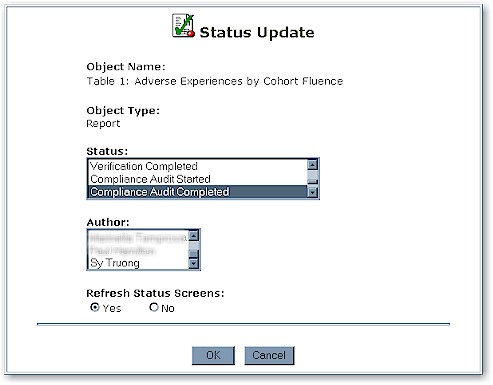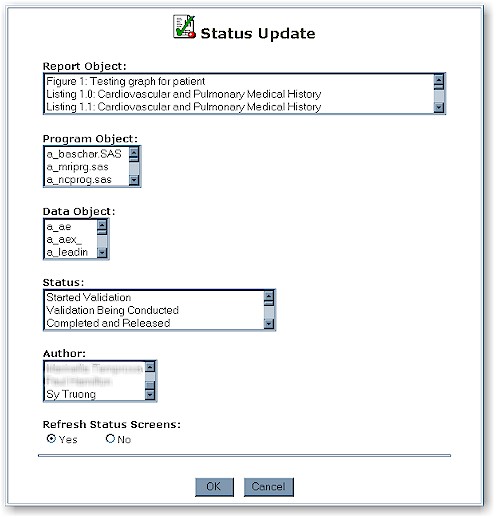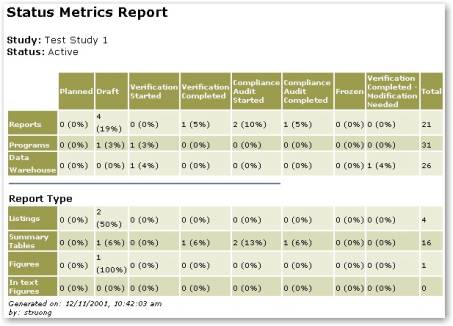Overview on Status View
Each object within the Trialex
System has a status associated with it. This is used for the purpose of tracking
changes to the clinical data warehouse as data flows
through it. The objects which contain user defined status information include: the
report, program and data objects.

Valid status values are defined by
the administrator during configuration of the
installation. Some examples of valid status values include:
- Planned
- Draft
- Verification Started
- Verification Completed
- Compliance Audit Started
- Compliance Audit Completed
- Frozen
The goal of the status view is to
give users the ability to view all the reports and the associated programs and data that
are used to generate that report. It also gives the project manager a tool to track
and assign the proper status to each object. During this review process, e-Notes can
also be generated that pertain to the status of each object. This is an effective
communication tool which can be used to direct and track changes to the reports.
The status view can be accessed
through the status icon found in the study conduct area.

>Status
The status view consists of three
columns of information pertaining to items found in the reports, programs and data
objects. The view is broken down by report type and is sorted by the order attribute
within the report object.

The objects are preceded by
checkboxes which allow users to pre-select items before they are updated through the Set
Status button. The Select All button for each column allows for quick
selection of all the items within the column. The objects selected by the check
boxes will be highlighted as default selections within the update status dialog box
available through the Set Status button.
The objects shown in the status
view contain hyperlinks which link to the report or documentation of that specific
object. For the report objects, the link will open a new window which contains the
HTML version of the report as it was generated on the webserver through the %txt2html utility. The program and data
objects link to the documentation which was generated from the documentation tools.
Each object which appears in the
status view is displayed with the status and author attributes. Attributes can be
updated for each object individually except for the source data object. Source data
comes from an external data management system so Trialex does not track them individually.
They are managed together with one status and author assigned to all source data.
The programs and data that are
shown in the same row as the report are used to generate the report. This
relationship is established from the dependency information.
The user can navigate from one
report type to the next by selecting the report type pull down menu. By selecting a
different report type then the one currently shown, the screen will navigate to the list
of the specified report type.
Every object that appears in the
status view is followed by status and author information. The word
"Status" contains a hyperlink that drills down to the status attribute of that
particular object. For example, if the user clicks on the status hyperlink next to
the report object for listing one, a screen will appear displaying the current status.

The status update screen allows
for the re-assignment of both status and author. Once the selection has been changed
and the OK button is pressed, the status database will be updated with the new
information.
It is optional to hold off on
refreshing the status screens after an update is applied. Since the refresh of the
status screen takes time, it is recommended that the refresh be applied
strategically. Another recommendation for refreshing the status is to run the %status macro in a batch program. This
is an efficient approach to refreshing the status compared to refreshing it
interactively. If, however, the status view needs to be updated immediately, the Refresh
button is available.
It is sometimes useful to apply
status updates to multiple objects at once. This can be accomplished by clicking on
the Status Attribute button on the main status view. The following dialog
box is presented displaying all the objects available for update.

Multiple objects can be selected
simultaneously and the status will be assigned according to the status selection.
Objects within this screen are pre-selected according to the items checked from the main
status view. Note that if only the status information is selected and the author is
not specified, only the status attributes will be updated for the selected object.
In a similar manner, if only the author is selected, only the author attribute will be
updated. The updates of status for multiple objects affect the status
database. It is optional to have the status screen refreshed during an update or at
a later time. This option is similar to the single object status updates.
Every object that appears in the
status view contains an author attribute which is displayed after the object name.
The author user name is also a hyperlink which drills down to e-Notes.

The e-Note composition screen is
very similar to the ordinary e-Note. The email will be sent to the author and the
current user. It will also send a CC to all members who have been defined to this
study. Members to a study are defined in the user
privileges. The subject is populated by the object type followed by object
name. The study name is populated within the email text.
In addition to being able to send
an e-Note, the review of existing e-Notes for the current study is also available through
the Review All Notes button.
The status view is an interactive
screen displaying the most up-to-date information pertaining to the status of clinical
objects. It is therefore only viewable by a valid Trialex user. In the event
where the status information is useful for other users who are not Trialex users, a
publish tool is available to export the status view so it can be viewed as a static HTML
page.
By clicking on the Publish
button, a new HTML page is generated and populated on the web server in the default study
path.

The URL to the snapshot view of
the status is presented. The status view generated will look similar to the
interactive version except it will not have the drill down capabilities for setting status
or e-Notes. The advantage of the published status view is that it can now be seen by
non-Trialex users or it can be emailed to external collaborators.
A high level summarized view of
the status information is essential for effective management of individual elements within
a clinical data warehouse. The metrics report available through the Metrics button
delivers a concise report that is summarized by report type. An example of the metrics
report is shown below.

The columns are status categories which are defined by the
Trialex System configuration. The summary is a frequency and percentage count of
reports, programs and data for the current specified study. The reports are broken
down by report type and displayed as a sub-report for more in-depth analysis. These
statistics are metrics which lead analysts or project managers can use to monitor and plan
for optimal use of resources.
|